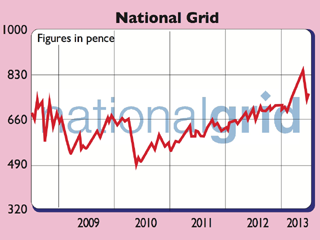
National Grid pays out better than bonds for just a little more risk, says Phil Oakley.
Many people rely on income from investments. In a world where interest rates have been held at rock-bottom levels for four years, finding decent levels of income without taking lots of risk has become more and more difficult.
Given this backdrop, it’s hardly surprising that investors have turned to utility companies’ shares. As we all need gas, electricity and water, these companies have reliable income streams, allowing them to pay chunky dividends.
A dependable dividend-payer
National Grid has been one of the most reliable dividend-payers. In the last decade it has grown its annual dividend per share at an average rate of 9.2% a year. Anyone who bought the shares ten years ago would now have an income return on their purchase price of 9.2%. If you bought shares in the company’s rights issue at 335p three years ago, your income return would be an impressive 12.2%.
National Grid has been able to pay bigger dividends for many reasons. Firstly, it has done a good job of running its regulated British gas and electricity networks. Despite the regulator, Ofgem, capping charges to customers, National Grid has invested a lot of money in its transmission and distribution assets. This has seen its regulatory asset value (RAV) grow a lot, which has allowed it to make more money as profits are a function of assets multiplied by the allowed rate of return on them.
It has also kept a tight lid on costs and spent less than its regulatory allowances. This has boosted profits and helped it make more money than the regulator expected. These extra profits have been paid out to shareholders.
National Grid has also taken advantage of low interest rates and taken on cheaper debt, enabling it to increase the difference between what it earns on its regulated assets and what it pays to lenders. That’s been good news for shareholders too.
Can it keep paying out?
The trouble is, utilities can only keep excess profits for a few years. Eventually, the regulator claws these back and passes efficiency gains to customers in lower bills. It also becomes harder for firms to cut costs. Regulators recognise that companies know more about their businesses than they do, so they challenge them to become more efficient with a carrot and stick approach. Bills are kept low with tough cost targets, but firms that do a good job can earn more money for a while. However, future returns will be lower, while interest rates stay low and there is less fat to cut. National Grid now aims for dividends to grow in line with retail prices index (RPI) inflation. But some analysts think this too optimistic.
National Grid has £22bn of debt. This will keep rising as its British and American businesses have big investment requirements. While this will let profits grow, a bigger share will go to lenders rather than shareholders. Will there be money left for bigger dividends? Another concern is that the American business has regularly earned less than its regulatory allowance. It often asks permission to raise bills to make up the difference.
There’s also the worry of rising interest rates. The firm must raise around £3bn of fresh debt each year to finance new investment and repay existing borrowings. Rising rates would make this pricier. But it’s also a problem for the share price. Utility stocks are good substitutes for bonds because of their dividends. Rising bond yields and falling bond prices could see National Grid’s share price fall too. In short, there’s rarely a free lunch in investing – but that’s why the shares yield 5.5%. On the upside, management is confident its dividend growth target can withstand most events. It also has a lot of regulatory clarity as it has just entered an eight-year price control in Britain.
So if dividends can grow in line with inflation, then I can think of worse homes for your money. National Grid’s shares could resemble an inflation-proofed bond, albeit with a little more risk. UK government index-linked bonds currentlyhave a real yield of minus 0.5% (0.5% less than inflation). With RPI inflation at 3.3%, National Grid yields 2.2% more than inflation (5.5% less 3.3%). Some premium is justified, but the shares look worth buying at current levels.
Verdict: buy for dividends
The numbers: National Grid (LSE: NG)
What the analysts say
Buy 8
Hold 6
Sell 4
Target Price 800p
Key facts
Stockmarket code: NG
Share price: 765p
Market cap: £28.1bn
Net assets (Mar 2013): £10.2bn
Net debt (Mar 2013): £22bn
P/e (current year estimate): 14.3 times
Yield (prospective): 5.5%
Interest cover: 2.3 times
Directors’ shareholdings
S Holliday (CEO) 2,322,164
A Bonfield (FD) 961,975
P Gershon (chair) 72,286